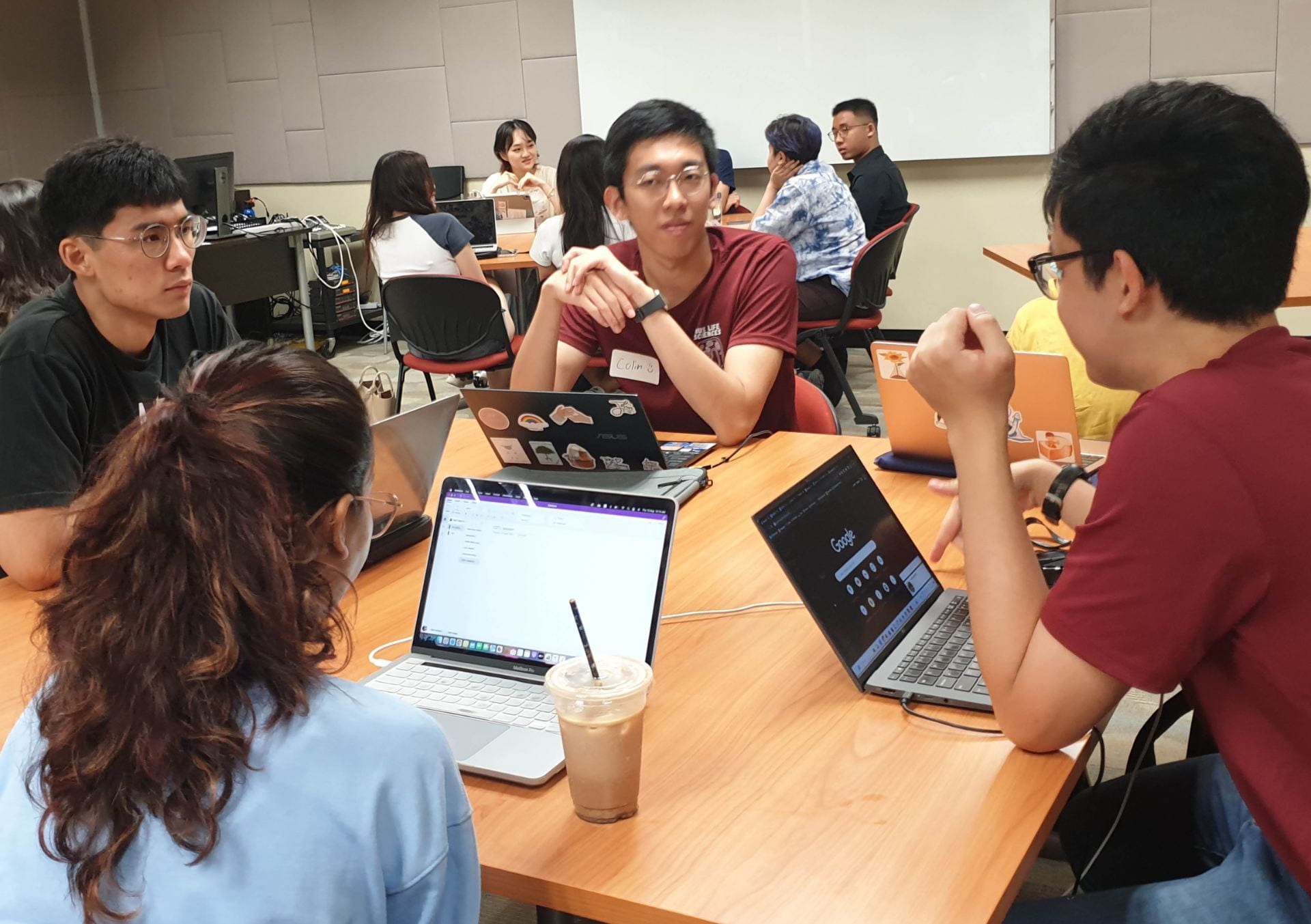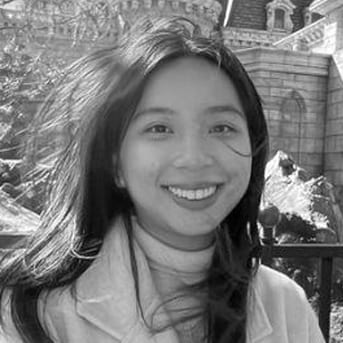Eliza LIM Siew Ping
Department of Philosophy, Faculty of Arts and Social Sciences (FASS)
Reflecting on the transformative journey within UTOP, Eliza shares insights on the collaborative efforts with a supervisor to reimagine pedagogy, integrate AI tools responsibly, and cultivate student-teacher partnerships.
In addition, Eliza’s UTOP mentor Jonathan SIM shares his perspectives of participating in the programme, which you can read here.
Undergraduate TAs participating in a UTOP session. (Photo credits: UTOP team)
Lim, E. S. P. (2024, February 26). From learners to collaborators: Exploring the role of student-teacher partnerships in UTOP. Teaching Connections. https://blog.nus.edu.sg/teachingconnections/2024/02/26/from-learners-to-collaborators-exploring-the-role-of-student-teacher-partnerships-in-the-university-teaching-opportunities-programme-utop/
The Undergraduate Teaching Opportunities Programme (UTOP) has been an incredible experience for me, and I am very grateful for the opportunity to learn under Mr. Jonathan Sim’s supervision in this programme. I applied for UTOP last semester (Semester 2, AY 2022/23) as I was very inspired after reading GEI1001 “Computational Reasoning”—the course challenged me to become better in this subject and it tackled areas I felt I lacked in, such as coding and Excel skills. I wanted to be a part of the GEI1001 Teaching Team so that I can help more students to benefit from the course. Little did I know that UTOP would prove to be so much more than just a continuation of that journey. It changed my perspective on education in a very profound way, especially as an aspiring educator.
My UTOP experience turned out to be a different experience from what I had initially imagined. I was pleasantly surprised by the level of autonomy and responsibility entrusted to me. From developing lesson plans to conducting research, the role was inherently student-driven, granting me the freedom to explore and implement my own ideas. This unique opportunity allowed me to truly take ownership of my work. While some tasks felt daunting and challenging at times, Jonathan consistently emphasised his willingness to help and support us whenever we needed. We met once every two to three weeks, where we checked in with each other, and Jonathan offered valuable advice and guidance on our progress.
There was one particular project that left a deep impression on me. We were tasked to design a new tutorial activity involving generative artificial intelligence (AI) tools. I was tasked with experimenting with various tools like ChatGPT and ChatSonic, and to create a lesson plan that would introduce these tools to students while also teaching them how to use them effectively and critically. This was a very meaningful experience for me, as we were entrusted with this project at the time when the ethical concerns around AI were hotly debated worldwide.
As someone new to lesson planning, I occasionally found myself questioning my progress. Yet Jonathan consistently provided encouragement and valuable feedback for improvement. During our meetings, we would discuss the appropriate utilisation of ChatGPT in academic and professional settings, broadening my perspective on how AI tools can be effectively harnessed in the future. I am glad that in participating in this endeavour, I not only provided students with practical skills but also engaged in a larger conversation about responsible AI usage that eventually made its way into the tutorial activity.
Throughout this experience, I realised that my role extended far beyond merely assisting Jonathan; instead, I was working alongside him as a valued collaborator. This realisation empowered me to do better, taking on greater responsibility and approaching my tasks with increased focus and dedication. Knowing that my opinions and ideas held weight encouraged me to contribute meaningfully to the projects we embarked upon. Furthermore, Cook-Sather and Alter (2011) emphasise that student-teacher partnerships promote empowerment and increased responsibility among students, aligning closely with my own experiences. Partnerships lead to enhanced engagement and a greater willingness to contribute meaningfully to collaborative projects, underscoring the positive impact of student-teacher collaboration.
As I learnt about the meticulous planning and thoughtful considerations that go into designing tutorials for GEI1001, such as utilising the application of teaching theories like Bloom’s Taxonomy (Forehand, 2010) and the Theory of the Five Awarenesses of Teaching (Rodriguez et al., 2020) to shape our instructional methods and lesson content, my understanding of pedagogical approaches and the strategic choices made in structuring lesson content deepened significantly. This newfound insight has shed light on the dual role teaching assistants (TAs) assume within UTOP. As both learners and teachers, we are in a unique position that allows us to bridge the gap between students and their lecturers, fostering trust and facilitating effective communication to enrich the learning experience.
Through collaborative efforts with my UTOP supervisor and the entire GEI1001 Teaching Team, I have witnessed how education can be a dynamic and collaborative process that promotes transparency between lecturers and students. For example, the team places a high value on honesty, encouraging us to voice any questions or provide feedback for improving lesson content and teaching methods. Similarly, students are more open to student teachers and are more likely to share honest feedback, enabling them to bring this feedback to the team for discussion and further improvement. Establishing this foundation of trust is paramount for ensuring effective learning outcomes (Cook-Sather, 2011) and creates an environment that facilitates responsible utilisation of advanced technological tools, such as ChatGPT, where educators can effectively guide students in navigating the digital landscape.
Participating in UTOP has reshaped my perspective on teaching and learning. It has underscored the importance of cultivating educators who possess the skill and expertise to adeptly guide students through uncertainties and challenges. As we continue to adapt to a rapidly changing educational landscape, it is essential to embrace this student-teacher partnership, enabling us to create a more inclusive learning environment for all.
References
Cook-Sather, A., & Alter, Z. (2011). What is and what can be: How a liminal position can change learning and teaching in higher education. Anthropology & Education Quarterly, 42(1), 37-53.
Cook-Sather, A. (2011). Lessons in higher education: Five pedagogical practices that promote active learning for faculty and students. Journal of Faculty Development, 25(3), 33-39.
Forehand, M. (2010). Bloom’s taxonomy. Emerging perspectives on learning, teaching, and technology, 41(4), 47-56.
Rodriguez, V., Solis, S. L., Mascio, B., Gouley, K. K., Jennings, P. A., & Brotman, L. M. (2020). With awareness comes competency: The Five Awarenesses of Teaching as a framework for understanding teacher social-emotional competency and well-being, Early Education and Development, 31(7), 940-72, http://dx.doi.org/10.1080/10409289.2020.1794496
 |
Eliza LIM Siew Ping is an undergraduate pursuing her Bachelor’s in Arts at the National University of Singapore (NUS). She is interested in learning new languages, and during her free time, she enjoys reading and crocheting. Eliza is currently learning Japanese and has been awarded a year-long overseas scholarship to study in Japan for AY 2023/24. Eliza can be reached at e0774019@u.nus.edu. |

